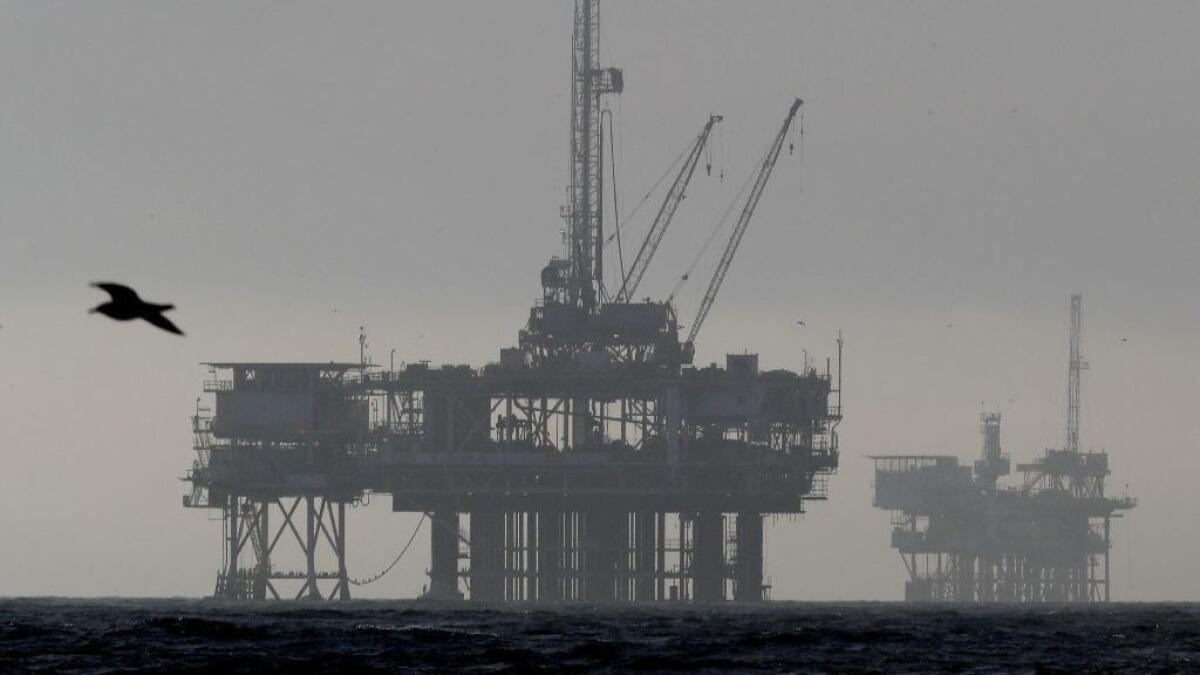Trump might limit states’ say in offshore drilling plan. Here’s how

Reporting from Washington — When President Trump proposed opening nearly the entire U.S. coastline to more offshore oil and gas drilling, the backlash from states seeking exemptions was swift.
Governors, Republican and Democratic, and state legislatures up and down the Atlantic and Pacific coastlines protested so vigorously that the administration promised to consult with them before finalizing any plans.
Instead, Trump is quietly laying the groundwork to weaken a decades-old federal law that empowers California and other states to slow and even stop offshore development in federal waters.
“Republicans are always supposed to be in favor of states’ rights,” said Richard Charter, who has worked on oil issues for 40 years and is a senior fellow at the marine conservation nonprofit Ocean Foundation. “But this is in fact an effort to take away states’ rights when it comes to offshore drilling.”
In a notice published earlier this month, the Commerce Department’s National Oceanic and Atmospheric Administration asked the public to weigh in on ways to “streamline” a state review process granted under the Coastal Zone Management Act.
GRAPHIC: Here is where the Trump administration wants to expand offshore oil and gas drilling »
The 1972 law is widely considered one of the most powerful tools states have to regulate activity off their coasts. It applies to all of the coastal and Great Lakes states, with the exception of Alaska.
The act gives states a voice when federal projects or industry development affect their coast, even activities that occur outside a state’s jurisdiction, which extends three miles from the coast.
The scientific agency can’t change the law, but through regulation and implementation, it can have a major impact on how it is enforced.
Among other things, the administration appears to be considering limits to the scope of states’ review powers and a shorter period of time to process an appeal. The full extent of its plans is unclear.
The goal, officials wrote, is to provide “greater efficiency and predictability” for oil and gas projects — language often used to justify deregulation.
The oil industry cheered the administration’s move.
“We appreciate and support efforts to modernize and improve the governance and efficiency of the permitting and approvals process so that unnecessary barriers to oil and natural gas development are minimized and eliminated,” said Erik Milito, a vice president of the American Petroleum Institute.
Passed in the wake of the devastating 1969 Santa Barbara oil spill, the act assures that drilling, shipping, commercial fishing, mineral extraction, wind power projects and other activities fit into states’ plans for protecting their coastal zones.
In practice, this means that activity in federal waters that would otherwise not be open to extensive public scrutiny can be subjected to hearings and local environmental impact assessments.
State leaders can insist on modifications. They can negotiate with industry representatives to reach a compromise. According to a 2016 NOAA report, states end up approving 93% to 95% of the federal projects they review. Supporters of this coordinated review process say it has resolved some of the nation’s most contentious cases without costly litigation that can drag on for years.
And though their word is not final, states have used the act as a weapon to defeat projects that threatened the environment and public health.
Citing the law in the early 2000s, California managed to halt 36 controversial oil leases between Monterey Bay and Channel Islands national marine sanctuaries.
In 2007, the state blocked a proposed liquefied natural gas port that would have floated 14 miles offshore from Ventura and Los Angeles counties. The project was ultimately abandoned after a state review found it posed significant risks to air quality and marine life.
“These regulations provide an important public process,” said Linda Krop, chief counsel at the Environmental Defense Center, a nonprofit environmental law firm based in Santa Barbara. Obtaining these rights has been a hard-fought battle by coastal states, with California leading the charge.
“It’s very meaningful,” she said, “and that’s what the federal government is afraid of.”
Mark Delaplaine, who manages the California Coastal Commission’s Energy, Ocean Resources and Federal Consistency Division, said attempts to weaken the law were alarming.
“It gets to the heart of arguably the most powerful tool, even with the checks and balances, that the state has. Period,” Delaplaine said.
This is not the only states’ rights battle California is fighting with the Trump administration, which is also seeking to end California’s unique ability to set fuel-economy standards for cars higher than the federal level.
The Trump administration’s draft offshore proposal would allow new oil and gas drilling in more than a billion acres off the Atlantic, Pacific and Arctic coasts. It includes plans for 47 lease sales over a five-year period, more than half of which would take place in the Gulf of Mexico and off Alaska.
The plan would give the oil and gas industry the first new access to California waters in decades, with six proposed lease sales. Another lease sale would be held off Washington and Oregon. Governors of all three states have vowed to protect their coastlines from offshore drilling.
Some now fear the Interior Department is slow-walking the unpopular plan to avoid upsetting the nomination of David Bernhardt, the agency’s acting chief, who faces a Senate confirmation hearing later this month. A revised draft of the offshore plan — which was expected earlier this year — has been delayed without explanation.
On Wednesday, 17 senators sent a letter to Bernhardt asking him to clarify how much of the country’s coast would be included in the plan. “The American people deserve to know your plan for the Outer Continental Shelf before the Senate votes on your nomination,” they wrote.
Florida politicians who secured the Interior Department’s promise a year ago to exempt the state from new offshore drilling were scrambling to figure out whether the administration would honor it. Florida’s entire congressional delegation signed a letter last month asking to be left out of Trump’s offshore drilling plan.
New Jersey, Delaware, New Hampshire, California and other states passed laws prohibiting new oil and gas pipeline and other infrastructure from being built on state lands — an attempt to make transporting oil prohibitively expensive.
Cindy Zipf, executive director of the New Jersey advocacy group Clean Ocean Action, said the states’ resistance likely prompted the administration’s effort to reduce their power by revising the coastal law.
“I do think this is blowback from President Trump in response to the states’ actions to block oil and gas drilling and infrastructure in state waters,” Zipf wrote in an email.
Trump has also tried to weaken the law by gutting its funding.
In his recent budget proposal, the president sought to end the grants given to states to help implement their coastal management programs, which include reviewing federal offshore activities. The administration made a similar attempt last year, but Congress restored funding in the final budget.
Previous administrations have also tried to limit states’ role in overseeing what happens in federal waters — part of a decades-long tug of war.
In the 1980s, California sued the Reagan administration to protect its right to review activities occurring off its coast. Under former President George W. Bush, key parts of the review process were expedited “to address concerns raised by the energy industry,” according to a NOAA report.
Delaplaine, of the California Coastal Commission, said that when he started in 1976, California lacked any review authority in federal waters.
When Exxon asked that year to build an offshore storage and treatment facility in state waters less than a mile from shore, the commission denied the project. So Exxon moved the project 3.1 miles offshore, into federal waters, and built the same storage and treatment facility. The state couldn’t do anything about it.
“The risk of oil spills was enormous,” Delaplaine said. “So this tool is infinitely powerful — we don’t have absolute authority ... but the state can be a lot more involved in the process to negotiate less environmentally damaging alternatives to a project.”
More stories from Anna M. Phillips »
More to Read
Get the L.A. Times Politics newsletter
Deeply reported insights into legislation, politics and policy from Sacramento, Washington and beyond. In your inbox three times per week.
You may occasionally receive promotional content from the Los Angeles Times.












